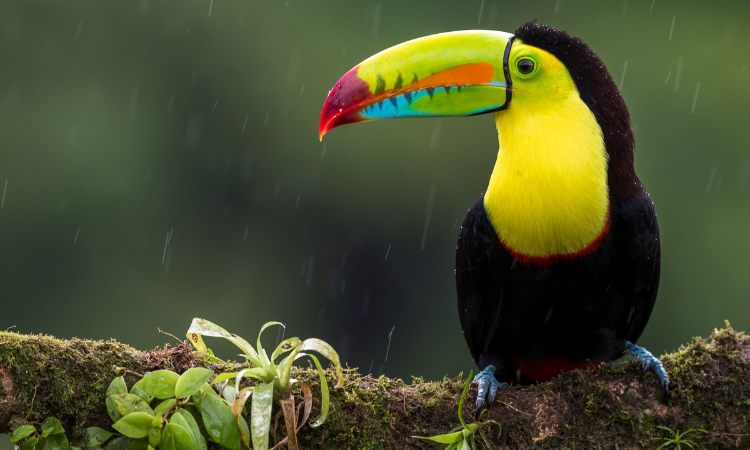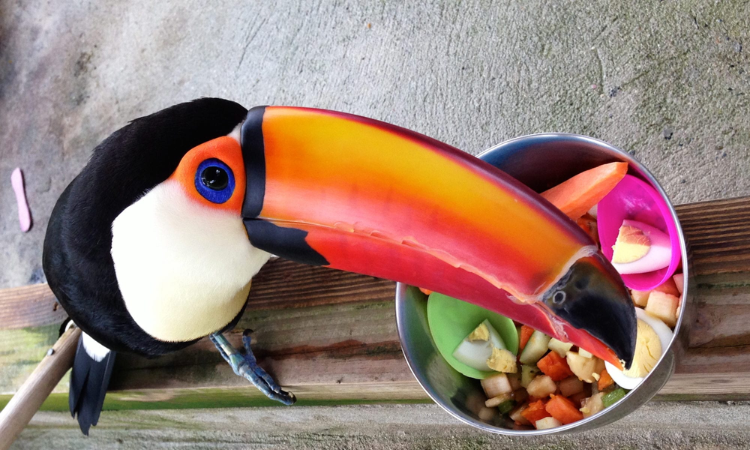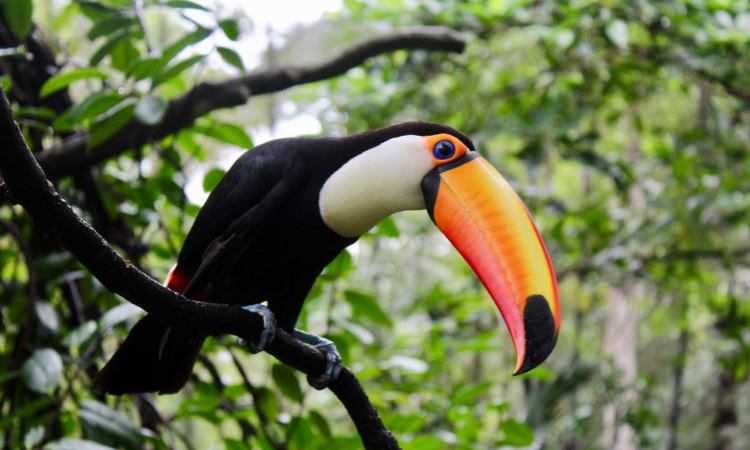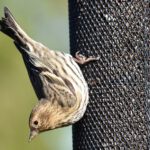I get a lot of questions from other bird lovers who want to provide toucans with a loving home. I am an avian conservator with over 7 years of expertise in taking care of exotic birds. However, designing the perfect home for these unusual creatures necessitates learning about their native environment and habits. I’ll provide professional advice on creating the ideal toucan habitat in this post, drawing from my extensive expertise and practical experience.
Reasons Toucans Make Interesting Pets
Toucans are becoming more and more popular as pets, and it’s easy to understand why with their large, brightly colored bills and lively personalities. I’ve learned from years of working closely with these birds at my aviary that toucans create deep ties with their owners and flourish when provided with adequate space and enrichment.
Many visitors, nevertheless, are unaware of the unique requirements that these tropical birds have. Well-meaning caregivers frequently put their toucans’ health and pleasure in danger by neglecting to reproduce important aspects of their native habitat.
As a leading figure in the avian world, I want to make sure that these amazing animals get the considerate attention they need. When given the proper environment, toucans make incredibly interesting friends.
Indoor Enclosure vs. Outdoor Aviary

The first thing to think about while building a toucan’s habitat is whether it will be mostly indoors or outdoors. Because they are native to the lush rainforests of Central and South America, toucans need year-round temperatures that are relatively warm and humid.
My own experience has taught me that in temperate areas. It’s best to house toucans in a dedicated outdoor aviary where they can enjoy sunshine and fresh air, but are still protected from inclement weather. I now know that for toucans to maintain their body temperature and activity levels. Outdoor enclosures must have a heated, insulated shelter that they may escape to when necessary.
A toucan’s natural habitat can be effectively recreated in well-designed indoor enclosures for residents of tropical or subtropical areas. Toucans in indoor environments need careful management of humidity and temperature to ensure their comfort and well-being. To stop the spread of airborne diseases, proper ventilation is also essential.
Once, the owner of a cherished pet toucan named Rio placed an air filter without realizing it wouldn’t adequately trap airborne yeast and fungal spores, and Rio ended up with a serious respiratory ailment that required medical attention. Such deadly infections can be avoided by first speaking with an expert in avian health.
Measurements
Many first-time caregivers misjudge how much space these gregarious, active birds need when they picture their toucan home. Toucans in the wild are used to flying great distances every day to find different fruits and places to nest. Enough space for them to hop, glide, and flap their wings is ideal for their survival.
Over the years, I’ve learned via trial and error with my flock of rescued toucans that, to safely contain one toucan, enclosures should be at least six feet wide by six feet deep by eight feet tall. The width and depth should be increased by 50% for every extra bird. Maintaining appropriate activity levels and reducing conflict are two benefits of proper spacing.
I vividly remember a kind-hearted customer who saw her two toucans becoming more reclusive and agitated in their tiny cage and asked for my advice.
Substance

The substrate is essential to recreating the natural habitat of toucans, as they spend a lot of time hopping along jungle floors in search of fallen fruit. However, choosing the right flooring material can be difficult when attempting to strike a balance between authenticity and practicality.
In my early days of toucan care, I occasionally employed substrates that looked natural, such as sand, mud, or even straw. But as I quickly found out, if these organic materials aren’t replaced often, they can encourage mildew and dangerous dust. Furthermore, loose particles frequently stuck to the moist meal of the toucans and were inadvertently consumed, raising concerns about gastrointestinal impaction.
After years of experience, I’ve concluded that the optimum substrate for toucan cages is easily cleaned concrete flooring covered with turf carpet or soft rubber matting. The non-degradable, textured carpets offer safe tread. When necessary, they may be easily removed and cleaned during routine deep cleanings.
I will always remember the lesson I learned from Mango, a young toucan who suffered from a persistent digestive disturbance until I found and changed the moldy straw substrate in his enclosure. After being placed in a dust-free, clean environment, his symptoms quickly became better.
Perches
High above the rainforest floor, in tree hollows, toucans spend the majority of their time perching and building their nests in their treetop home. Their special zygodactyl feet have two toes pointing forward and two facing back for better gripping abilities.
To avoid pressure sores on the delicate feet of toucans, I much rather use natural tree branches than stiff dowel perches. Their powerful grasp is aided by the uneven, textured surfaces, which also replicate the unpredictability of wild perches. Years of experience engaging with these birds have shown me that they enthusiastically explore and play among the well-designed network of perches in their home.
I choose non-toxic, pesticide-free wood that has properly dried for at least a year before gathering branches to avoid mold growth. Similar to rainforest trees, softer types like willow or magnolia are good for toucans because they let their claws dig in. Each year, I swap out the deteriorating perches.
I’ve learned from watching my toucans over time that their ideal habitat is lots of high roosting perches dotted with lower perches for entertaining and engaging with caregivers.
Enhancement
Throughout their daily travels through the biologically rich rainforest. Toucans come across a limitless variety of sights, sounds, smells, and textures. In every toucan habitat I create, I try to bring out the natural curiosity and intellect of each bird by including different kinds of sensory stimulation.
Rio, a young toucan, had damaging plucking tendencies that taught me an important lesson early in my aviculture career. Rio would frequently tear out his breast feathers violently and cry for hours on end. Despite having access to plenty of food and a sturdy enclosure. I didn’t realize at the time that his self-mutilation was a sign of extreme stress and boredom.
Rio’s discomfort quickly subsided after I gave him additional options for mental exercise and stimulation. Like as training sessions, shreddable toys, and puzzle feeders. His unsettling outbursts taught me that for toucans to flourish in captivity. Creative enrichment is just as important as physical room.
Branches, bells, wood blocks, wiffle balls, puzzle reward dispensers, and other breakable items that encourage toucans’ natural foraging habits are now a staple in every habitat I create. I constantly switch up new items to keep them interested.
Interacting with caretakers through basic training exercises provides invaluable mental stimulation as well.
By continually enhancing sensory variety and challenge in my aviary. I’m rewarded with vibrant, content toucans eagerly engaging with their surroundings. Their visible resilience demonstrates why enrichment is equally as important as diet when aiming to replicate wild existence.
The Journey of a Lifetime
Welcoming toucans into your life is a momentous commitment demanding significant time, effort and financial investment to ensure their wellbeing. However, I’m living proof that the profound bonds formed with these remarkable companions make every challenge worthwhile.
It brings me profound joy to pass along lessons from my years of firsthand experience. So others can succeed in keeping happy, healthy toucans. With the right habitat and care.
If you remain committed to learning and making gradual improvements over time. You’ll be able to provide the nurturing environment toucans deserve. I wish you the very best on this incredibly fun, meaningful journey ahead!
Please don’t hesitate to contact me if you have any other questions about properly caring for toucans. I’m always happy to share insights from my decades of hands-on experience as an avian conservationist and exotic bird caretaker.
Read Also – The Fascinating World of Blue Jays: How to Spot and Identify Them

Stina is the expert behind BirdFacts.net, dedicated to sharing her passion and knowledge about birds. With a degree in Environmental Science and over 6 years of birdwatching experience, she brings both expertise and enthusiasm to her writing. Stina’s work aims to inspire appreciation for birds and promote responsible birdwatching. Follow her bird-filled journey on Instagram.





